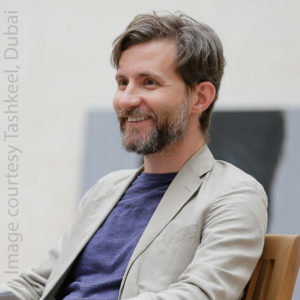Gallery Director Bio
Flounder Lee is an artist/curator and postgraduate researcher in Art & Media at the University of Plymouth, UK pursuing his PhD in art and curatorial practice, although he is based in Florida, USA on the stolen lands of the Timucua and Seminole. He was raised on the ancestral lands of the Yuchi, Shawnee, Muscogee/Creek, and Cherokee peoples in Alabama. He received his BFA from the University of Florida and his MFA from California State University Long Beach—both in studio art and photography. He then taught full-time at universities in the US, Malaysia, and Dubai for 12+ years.
Exhibitions curated include: The Future is…Ordinary? at the Shangyuan Art Museum, Beijing, China; On this night, for the first time, something will happen… at the Jean Paul Najar Foundation, Dubai, and Aerospacial at Herron School of Art and Design in Indianapolis. He founded and co-ran SpaceCamp MicroGallery, a tiny project space in Indianapolis. He has written several essays including for Tribe: Photography and New Media in the Arab World.
Several overlapping themes run throughout his work: decolonialism, mapping, science, the future, and environmental change. He uses various media such as photo, video, performance, sound, and installation to create work that touches on these topics.
His PhD project deals with mundane speculative futures through artistic and curatorial perspectives. He works using anti-oppressive practices—anti-racist, anti-colonial, anti-patriarchal, anti-heteronormative, anti-ableist, inclusive, and intersectional with decolonial and curatorial activism approaches.
What is my PhD project about?
My practice-research PhD project examines the overlap, differences, and intricacies between a wide range of current contemporary art practices that deal with mundane futures. I define mundane futures as ones dealing with the ordinary, everyday, between extremes of utopia and dystopia, but not necessarily boring, in other words one that most of us will most likely experience. Through developing an intertwined art and curatorial practice, I plan to investigate these looks at everyday futures that are more just and more sustainable. I’m interested in how art practices can imagine and forge these possibilities. Within these potential futures, I’m focusing on two core subthemes: technology and survivance. Survivance is a concept established by Anishinaabe cultural theorist Gerald Vizenor that goes beyond mere survival into actively creating thriving communities that are also integral to the world outside of their communities. While trying to find my place in helping co-create realities that are more just, I will work at finding ways of using practice to become an accomplice (more involved than an ally) in the struggle against injustice and oppression.
My work is about putting artists and artworks focused on mundane futures into conversation with one another. It is the outcome of a process of curatorial methods that I am developing called the Mycelial Model of Curating. This is based on building relationships and curatorial activism. The 4 Rs of Indigenous curatorial work form the basis for my mycelial model—Respect, Reciprocity, Responsibility, and Relationships. Care is baked into all my actions; it forms part of each of the Rs. I respect the cultures, protocols, feedback, advice, and work of all the others before me, working presently and who come after me. The Mycelial Model’s goal is to connect and support artists, curators, and other creatives in the way that mycelial networks connect and support their companion plants and each other. Ethical, curatorial activism, as defined by Dr. Maura Reilly, is the path I plan to follow for the curatorial portions of my practice-research project. Reilly asks in what way curators can contribute to the work of making the art world more inclusive.
